Quantifying the Effects of COVID Spikes on the Presidential Election
October 23rd, 2020
COVID is having a huge effect on our lives. And it’s having a huge effect on the presidential election.
COVID is devastating American communities and upending our lives. We’ve spent over four years looking at polling data that supports the narrative of Donald Trump can do anything and it won’t really matter. But it turns out that COVID outbreaks matter.
In states like Montana, Wisconsin, and Iowa, COVID rates are rising to new and awful levels. Our modeling suggests that higher COVID rates in an area drive significant numbers of voters from Trump to Biden, and may push Democratic candidates over the line in a number of key races.
Trump Losing Supporters in COVID-Affected Areas
Donald Trump is losing support in areas with high rates of COVID.
We looked at over 110,000 survey responses since June 1, from a mix of both private and public Change Research surveys. For each response, we looked at the recent rate of COVID cases in the respondents state or city, focusing our analysis on responses from voters in states experiencing high rates of COVID (defined as at least 240 diagnosed cases per million adults in the past seven days) and responses in states experiencing low COVID rates (under 70 diagnosed cases per million adults in the past seven days).
Among nearly all groups of 2016 Trump voters, respondents in states that are currently experiencing high rates of COVID are significantly more likely to say they plan to vote for Joe Biden. Among white college educated women who voted for Trump in 2016, for instance, Biden wins just 4.0% of voters in low-COVID states, but 5.8% of voters in high-COVID states. Trump’s vote share also goes down (from 89.1% to 87.7%), meaning Biden’s net margin improves by 3.2%.
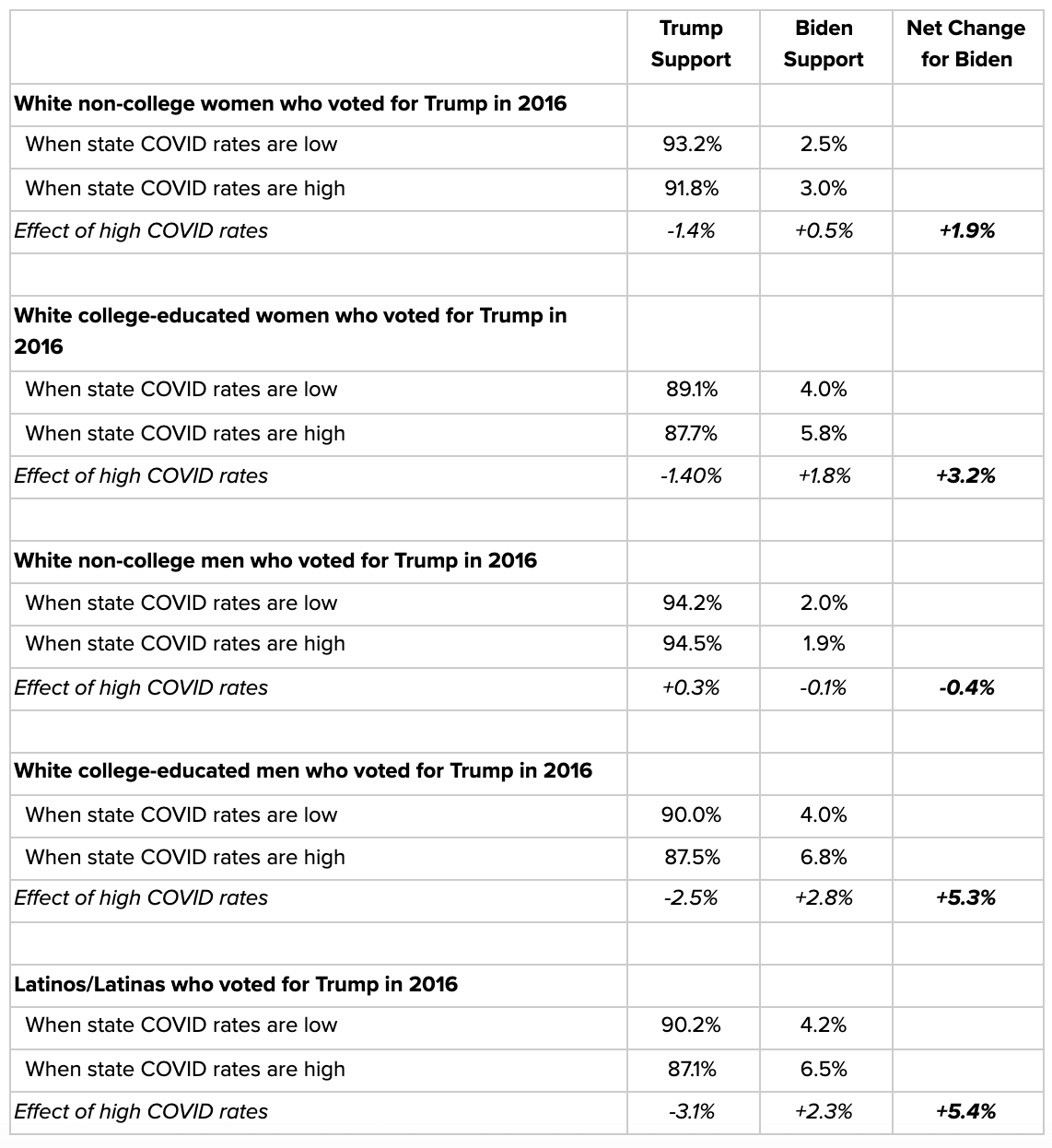
Overall, people who voted for Trump in 2016 and are living in high COVID states are about 50% more likely than people in low COVID states to support Joe Biden in 2020. This is most pronounced among 2016 Trump voters who are either Latino/a or college educated. Only 4% of college-educated male survey respondents in low-COVID states who voted for Trump in 2016 say they plan to vote for Joe Biden in 2020; in high-COVID states, that percentage increased to 6.8%.
Florida, South Carolina, Georgia, and North Carolina all saw summer spikes, followed by decreased COVID rates in the early fall. In these states, Biden received 7.2% support among college educated 2016 Trump voters and 2.9% among non-college Trump voters when COVID rates are high, but just 5.5% and 2% when COVID rates are moderate.
The following numbers since June 1 cover periods of both moderate (70-130 diagnoses/million adults) and high COVID rates in each state:

Among 2016 Trump voters, the effects are strongest among younger and more educated voters.
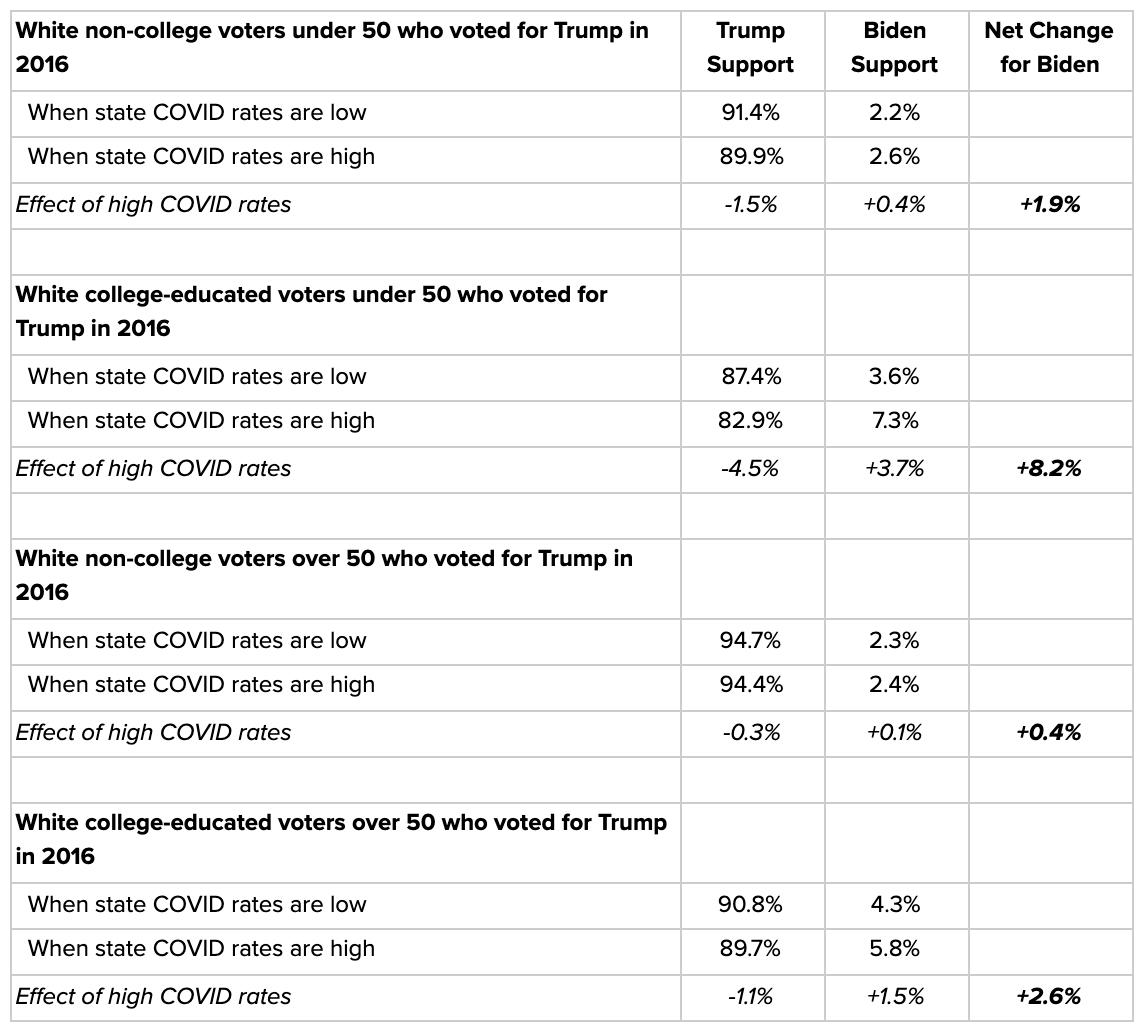
In our survey respondent data, we see that white college-educated voters under 50 who voted for Donald Trump in 2016 are twice as likely to vote for Joe Biden if they are answering from a state with high COVID levels.
Biden Holding Democrats in COVID-Affected Areas
Joe Biden is largely holding on to Hillary Clinton’s 2016 voters, and this is especially true when voters are seeing high COVID rates around them:
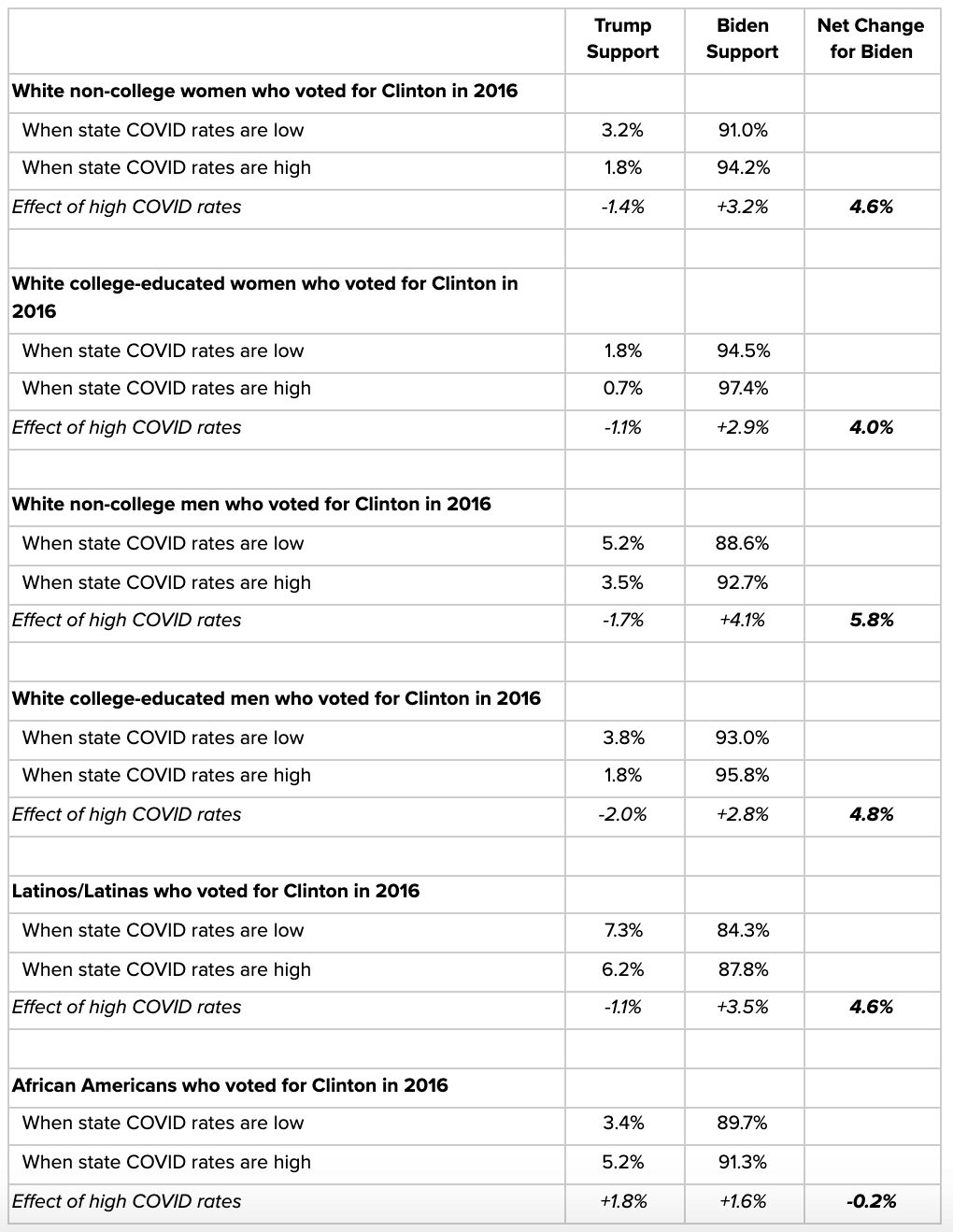
Joe Biden does appreciably better among all demographics in high COVID areas, with the possible exception of African Americans. College educated Clinton supporters in high COVID areas — both men and women — were less than half as likely to support Trump as college-educated Clinton supporters in low COVID areas.
The trends in Southern states have been similar, though the effects have been slightly smaller:
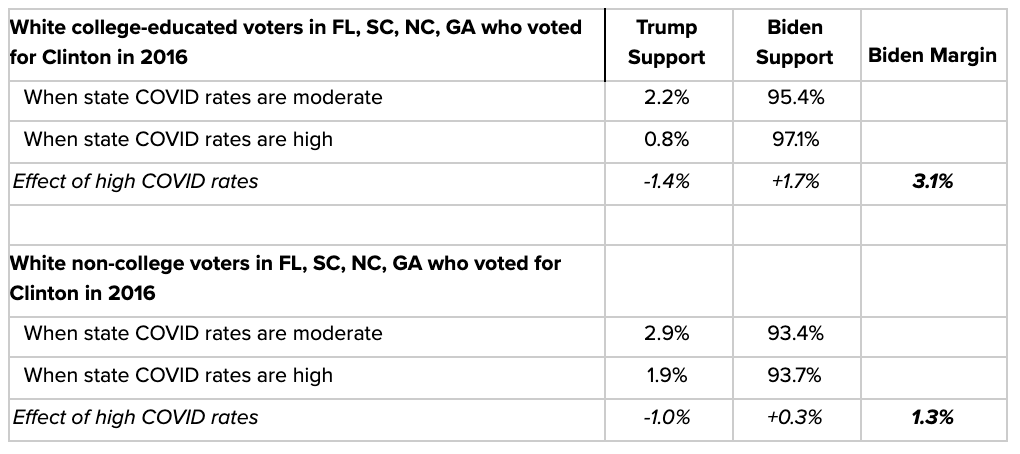
Pro-Biden? Or Anti-Trump?
In nearly all of our surveys, we ask respondents to rate both Donald Trump and Joe Biden on a 1-10 scale. Those ratings allow us to measure small attitudinal shifts toward each candidate.
These yield the following findings:
-
Voters who supported Hillary Clinton in 2016 in high COVID areas are both more supportive of Joe Biden and less supportive of Donald Trump. In low COVID areas, Clinton voters rate Trump an average of 1.49; in high COVID areas they rate him an average of 1.40 (difference: 0.09 points). Clinton voters in low COVID areas rate Biden 8.04 on average, compared to 8.23 in high COVID areas (difference: 0.19 points). Both differences are highly statistically significant.
-
Voters who supported Donald Trump in 2016 and live in high COVID areas have soured on President Trump more than they’ve embraced former Vice President Biden. In low COVID areas, Trump’s average rating is 8.92; in high COVID areas, it’s 8.85 (difference: 0.07 points). Biden’s rating increases by 0.03 points in high COVID areas, from 1.55 to 1.58.
Modeling COVID Effects
In an environment where partisanship seems to trump everything else, we were surprised to see such a large effect.
To validate these results, we ran several logistic regressions to try to tease out whether there might be something else at play. Models built to predict individuals’ responses included different combinations of:
-
Age
-
Gender
-
Ethnicity
-
2016 vote
-
Education level
-
COVID prevalence at the state level
-
COVID prevalence at the county level
-
County Trump-Clinton margin in 2016
-
Time (days since June 1)
Here are the results of one model which predicts Biden/other/Trump:
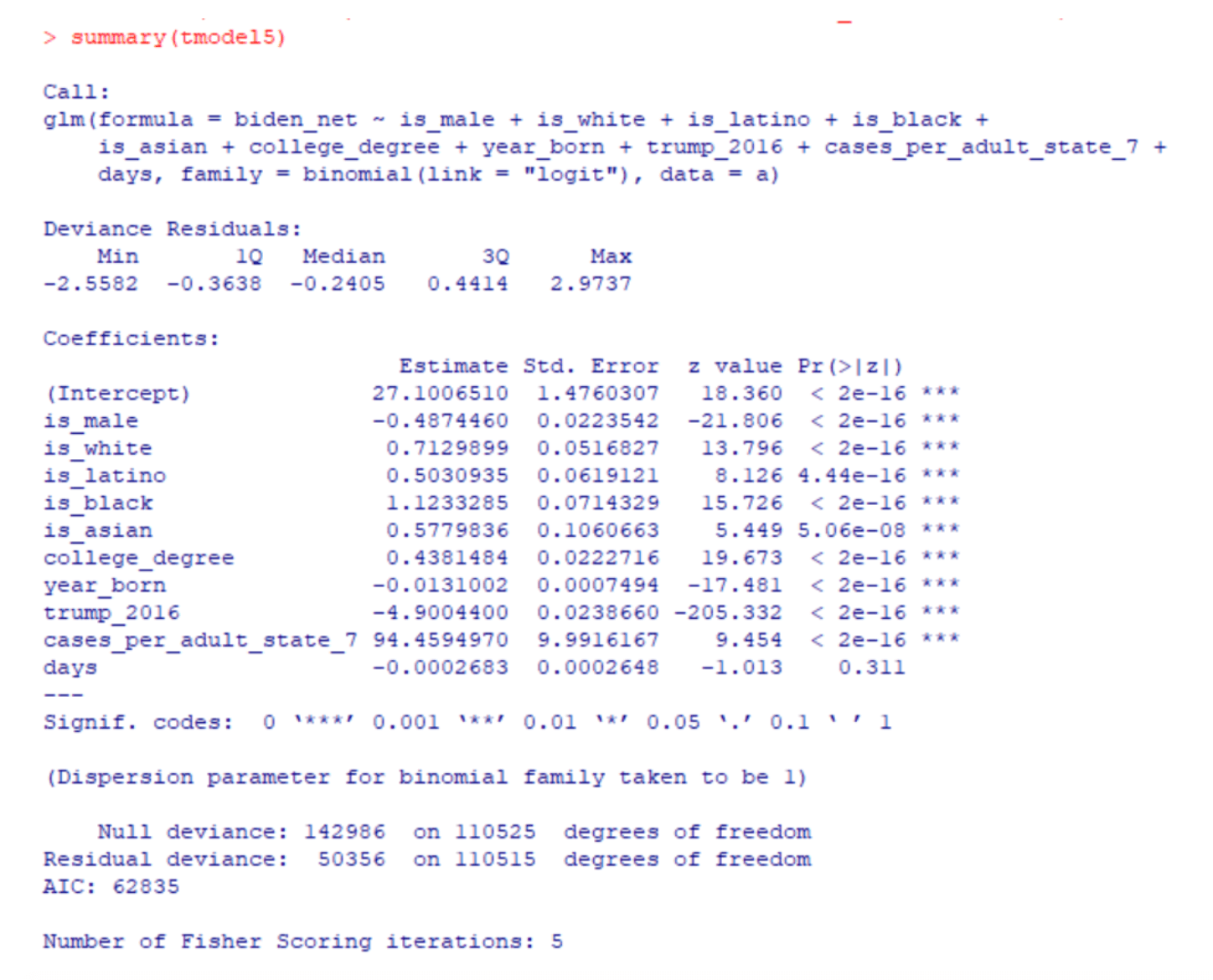
All of our models found highly significant effects for COVID prevalence, especially at the state level (county case rates tend to be noisier).
These models projected differences of 1.5-5 points in net vote for Biden, between a respondent in a low-COVID state or a high-COVID state.
Political Ramifications
This is an academically fascinating result, and we suspect that political scientists will be studying COVID effects on county- and state-level votes for many years to come.
More relevantly right now, Democrats should consider using this for resource allocation. That means putting money into districts or states that were somewhat close — R+5 or R+8 — a few weeks ago before a COVID spike, and now experiencing a spike.
Districts and states that were D+8 and now experiencing a spike may be more solid than they previously were.
College educated voters and voters under 50 are likely to be especially likely to move from Trump 2016 to Biden 2020.
Below are modeled vote shifts based on COVID incidence data from October 22:


The states with the largest modeled shifts are mostly very red states — North Dakota, South Dakota, Idaho, Nebraska, and Wyoming — with two purple-ish states in Wisconsin and Montana.
Here’s how Democrats might shift their strategies:
-
If Wisconsin’s outbreak continues, it will be even more of a longshot state for Trump.
-
Iowa’s high and increasing COVID rates put it in play in the Presidential race, and help Democrats in both Senate and House races.
-
North Carolina, Arizona, Pennsylvania, and Florida all have relatively low COVID rates right now. That means they are likely to stay closer than they might have been at their respective peaks.
-
Kansas, Alaska, and Montana are all in the category of tough-but-winnable Senate races for Democrats. If COVID rates continue to rise in those states, they could become even more competitive.
-
Reach Congressional districts in states like Wisconsin, Iowa, Oklahoma, Missouri, Montana, Indiana, Illinois, Colorado, New Mexico, and Minnesota may be worth a second look. A district that was R+4 a few weeks ago may be R+1 or even by November 3 if COVID rates continue to grow.
